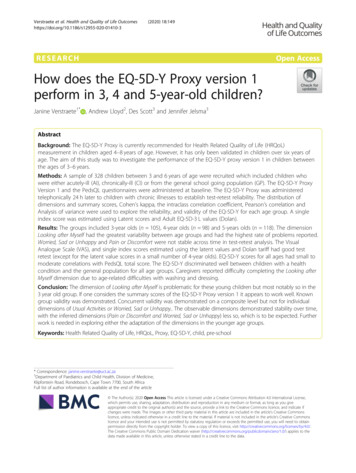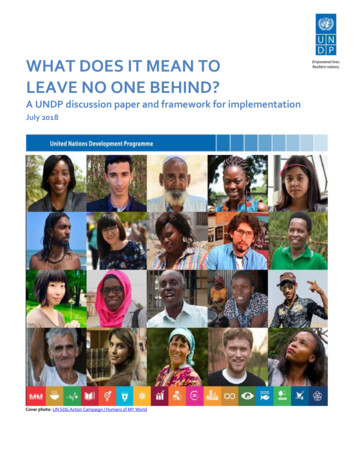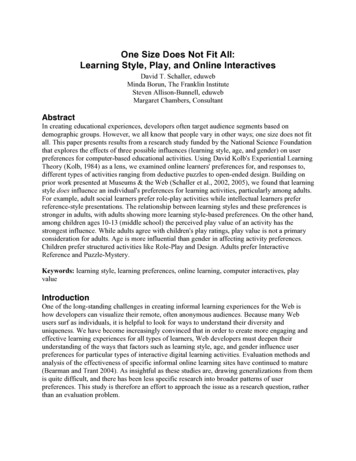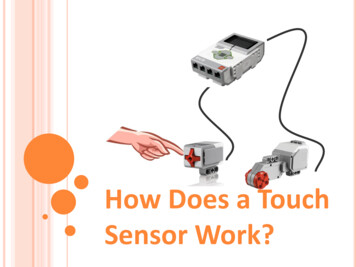
Transcription
Verstraete et al. Health and Quality of Life (2020) 18:149RESEARCHOpen AccessHow does the EQ-5D-Y Proxy version 1perform in 3, 4 and 5-year-old children?Janine Verstraete1* , Andrew Lloyd2, Des Scott3 and Jennifer Jelsma3AbstractBackground: The EQ-5D-Y Proxy is currently recommended for Health Related Quality of Life (HRQoL)measurement in children aged 4–8 years of age. However, it has only been validated in children over six years ofage. The aim of this study was to investigate the performance of the EQ-5D-Y proxy version 1 in children betweenthe ages of 3–6 years.Methods: A sample of 328 children between 3 and 6 years of age were recruited which included children whowere either acutely-ill (AI), chronically-ill (CI) or from the general school going population (GP). The EQ-5D-Y ProxyVersion 1 and the PedsQL questionnaires were administered at baseline. The EQ-5D-Y Proxy was administeredtelephonically 24 h later to children with chronic illnesses to establish test-retest reliability. The distribution ofdimensions and summary scores, Cohen’s kappa, the intraclass correlation coefficient, Pearson’s correlation andAnalysis of variance were used to explore the reliability, and validity of the EQ-5D-Y for each age group. A singleindex score was estimated using Latent scores and Adult EQ-5D-3 L values (Dolan).Results: The groups included 3-year olds (n 105), 4-year olds (n 98) and 5-years olds (n 118). The dimensionLooking after Myself had the greatest variability between age groups and had the highest rate of problems reported.Worried, Sad or Unhappy and Pain or Discomfort were not stable across time in test-retest analysis. The VisualAnalogue Scale (VAS), and single index scores estimated using the latent values and Dolan tariff had good testretest (except for the latent value scores in a small number of 4-year olds). EQ-5D-Y scores for all ages had small tomoderate correlations with PedsQL total score. The EQ-5D-Y discriminated well between children with a healthcondition and the general population for all age groups. Caregivers reported difficulty completing the Looking afterMyself dimension due to age-related difficulties with washing and dressing.Conclusion: The dimension of Looking after Myself is problematic for these young children but most notably so in the3 year old group. If one considers the summary scores of the EQ-5D-Y Proxy version 1 it appears to work well. Knowngroup validity was demonstrated. Concurrent validity was demonstrated on a composite level but not for individualdimensions of Usual Activities or Worried, Sad or Unhappy. The observable dimensions demonstrated stability over time,with the inferred dimensions (Pain or Discomfort and Worried, Sad or Unhappy) less so, which is to be expected. Furtherwork is needed in exploring either the adaptation of the dimensions in the younger age groups.Keywords: Health Related Quality of Life, HRQoL, Proxy, EQ-5D-Y, child, pre-school* Correspondence: janine.verstraete@uct.ac.za1Department of Paediatrics and Child Health, Division of Medicine,Klipfontein Road, Rondebosch, Cape Town 7700, South AfricaFull list of author information is available at the end of the article The Author(s). 2020 Open Access This article is licensed under a Creative Commons Attribution 4.0 International License,which permits use, sharing, adaptation, distribution and reproduction in any medium or format, as long as you giveappropriate credit to the original author(s) and the source, provide a link to the Creative Commons licence, and indicate ifchanges were made. The images or other third party material in this article are included in the article's Creative Commonslicence, unless indicated otherwise in a credit line to the material. If material is not included in the article's Creative Commonslicence and your intended use is not permitted by statutory regulation or exceeds the permitted use, you will need to obtainpermission directly from the copyright holder. To view a copy of this licence, visit http://creativecommons.org/licenses/by/4.0/.The Creative Commons Public Domain Dedication waiver ) applies to thedata made available in this article, unless otherwise stated in a credit line to the data.
(2020) 18:149Page 2 of 10IntroductionA key focus of the World Health Organisation (WHO)and its member states is the improvement of childhealth globally [1]. New measures of child health andhealth related quality of life (HRQoL) have been developed over the last two decades [2, 3]. HRQoL measuresaim to capture the subjective multi-dimensional constructs of HRQoL namely physical, social and psychological functioning which are relevant to health [4, 5].By definition, an individual’s HRQoL is subjectiveand should be elicited by self-report whenever possible, even from children [6]. This is not always possible as there are those who are either too young orcognitively unaware to self-report and so it is necessary to rely on proxy report [6–8]. For younger children below the age of 7–8 years it is usually necessaryto rely on proxy report [9].The EQ-5D-Y was developed and validated for children and adolescents aged 8–18 years by an international team from the EuroQol group [10]. The youthversion of the instrument was derived from the EQ-5D3 L, an adult HRQoL instrument which is often used tosupport economic evaluation. The EQ-5D-Y includesfive dimensions which are similar to the original EQ5D but adapted for children and a Visual AnalogueScale (VAS) for an overall rating of health on a scale,with 0 indicating worst health imaginable and 100 indicating best imaginable health. Although a protocol hasbeen developed for the valuation of the EQ-5D-Y avaluation set is not yet available [11]. A latent scoringsystem has been previously developed using a discretechoice experiment (DCE) which will be used as a composite score in this study [12].The EQ-5D-Y Proxy is a direct adaptation of the EQ5D-Y for proxy completion and is currently recommended by the EuroQoL Foundation for use in childrenaged 4–8 years and older children if they cannotcomplete the forms themselves [13]. The proxy versionhas been validated in a Spanish study in children over 6years of age [14]. However, much less is known aboutthe psychometric performance of the measure in younger children. This study aims to test the psychometricproperties of the EQ-5D-Y Proxy version for children inthree age groups: 3 years, 4 years and 5 years. The studywas designed to explore if the psychometric performanceof the measure is systematically worse when used withyounger children. This then could provide an empiricalbasis for recommending which children the measure canbe used with.Africa. The paediatric hospital admits acutely-ill (AI)children to the in-patient facility and manageschronically-ill (CI) children in the out-patient facility.The pre-primary schools accept children from the general population (GP), some of whom may have minorhealth conditions. The HRQoL data were collected fromtheir primary caregivers (typically a parent).Recruitment was restricted to caregivers who wereliterate in English (due to the unavailability of translations of some the instruments into the local languages).Children who were medically unstable or critically ill inthe intensive care unit were excluded.Verstraete et al. Health and Quality of Life OutcomesMethodologyParticipantsChildren aged 3–6 years were recruited from a paediatrichospital and pre-primary schools in Cape Town, SouthMeasuresDemographic and medical informationThe survey also included background questions to record age, gender, diagnosis and relationship of caregiverto child. Caregivers were asked whether each of the EQ5D-Y dimension questions was suitable for the age oftheir child and, if not, to please provide an explanation.EQ-5D-Y Proxy version 1The EQ-5D-Y Proxy version 1 includes five dimensions:Mobility (walking about), Looking after Myself (washingand dressing), Usual Activities, Pain or Discomfort andWorried, Sad or Unhappy. Each item has three responselevels corresponding to ‘no problems’, ‘some problems’and ‘a lot of problems’. Participants are also asked torate the global health of the child on a Visual AnalogueScale (VAS) from worst imaginable health (0) to best imaginable health (100) [15, 16]. Proxy version 1, whichasks the respondent to rate the child’s HRQoL fromtheir own viewpoint was used in this study [17]. A betatelephone-based EQ-5D-Y Proxy version 1 was used forrepeat assessments which includes a telephonic scriptfor interviewer to ensure standardisation for completion.The EuroQoL Group defines a Beta version as one thatis in the final stages of development but is not yet recognized as an official version.Pediatric Quality of Life Inventory (PedsQL)The PedsQL is a widely used HRQoL measure withproxy versions for children as young as 2 years of age[18]. The PedsQL consist of four dimensions of functioning: physical, emotional, social and school with 8,5,5and 5 items respectively. Each item is scored on a Likertscale from 0 to 4 (never a problem to almost always aproblem). Items are reversed scored and transformed toa 0–100 scale: 0 100, 1 75, 2 50, 3 25, 4 0. Dimension scores are calculated by a sum of the itemscores divided by the total number of items. A totalscore is similarly generated by summing the dimensionscores over the total number of dimensions giving anoverall HRQoL score. A higher PedsQL score indicates a
(2020) 18:149Page 3 of 10better HRQoL. The PedsQL is a profile measure whichhas been utilised previously to explore the concurrentvalidity of the EQ-5D-Y [19–21].summarised in terms of frequency of responses to eachdimension across the age categories. Single index scorewere calculated using both the adult EQ-5D-3 L UnitedKingdom (Dolan) tariff [23] and the EQ-5D-Y summarylatent value [12]. The Dolan Tariff is valued between 0.594 and 1.000 with a higher value indicating a betterHRQoL. Similarly, the Latent scale is valued between 9.306 and 0 with a higher value indicating a betterHRQoL. Test-retest reliability was assessed using thekappa statistic for dimension scores and the IntraclassCorrelation Coefficient (ICC) for summary scores. Kappavalues were interpreted according to Landis and Koch’sguidelines with kappa 0.2 poor agreement, 0.21–0.40fair agreement, 0.41–0.60 moderate agreement, 0.61–0.80 substantial agreement, and kappa 0.81 indicatingalmost perfect agreement [24]. An ICC of 0.7 wasconsidered reliable [25]. The concurrent validity of thedimension scores of the PedsQL and EQ-5D-Y was determined using the Partial Eta Squared. Interpretation ofPartial eta-squared is: small effect (0.01), medium effect(0.06) and large effect (0.14) [26] . Pearson’s r was usedto explore the concurrent validity between EQ-5D-Ydimension summary scores (Latent value, Dolan tariff)and EQ-5D-Y VAS and summary scores on the andPedsQL. For known-group analysis children who wereAI and CI were combined into a group labelled healthcondition for comparison to those who were from thegeneral population across the age groups. As the groupof AI and CI children were heterogenous expected differences between AI and CI could not be hypothesised,it was however expected that children with a healthcondition would report worse HRQoL than those without. The known-group validity was assessed for themean Latent score, Dolan tariff and the VAS groupsacross the age groups by computing the Analysis ofVariance (ANOVA).Verstraete et al. Health and Quality of Life OutcomesProcedureEthical approval for the study was granted by theHuman Research Ethics Committee of the Faculty ofHealth Sciences, University of Cape Town (HREC/REF:825/2017) and approval was gained from all relevantauthorities. The study plan was also reviewed andapproved by the EuroQol Group. Children were recruited during either routine outpatient visits or fromthe in-patient facility at the children’s hospital. Childrenfrom the general population were recruited from preschools during a pre-arranged period with the schooland caregivers.The purpose and procedure of the study were explained to the parents/caregivers by one of the researchers and informed consent was obtained fromthose who indicated willingness to participate. Caregivers of CI children were asked to provide a repeattelephone-based assessment after 24 h to determine thetest-retest reliability. The same caregiver was asked toanswer the repeat telephonic measure of the EQ-5D-YProxy for that day as per the telephonic script, both thecaregiver and interviewer were blinded to previous responses. There are no current guidelines on the timeperiod of test-retest reliability and Marx et al. (2003)have found no difference between 2 days and 2 weeks[22]. Due to the heterogeneity of the CI sample a timeperiod of 24 h was selected to ensure that no healthrelated changes occurred with repeat measurement. GPchildren were not included for test-retest as we expectthem to report no problems in most dimensions withlittle variance for test-retest reliability.A detailed description of the study, informed consentand the research pack (EQ-5D-Y Proxy, PedsQL andbackground questionnaire) were sent home with each ofthe children attending the pre-schools. The caregiverswere given 1 week in which to provide informed consentand to complete the research pack.Data analyses and managementThe sample size was powered to detect a difference inproportions across the three age bands. The degrees offreedom were thus [2 groups (GP and those with ahealth condition) -1] [5 levels 1] 5. It was anticipated that the effect size of the age bands would besmall, i.e. 0.3. A minimum total sample of 220 children,i.e. 220 GP and children with a health condition was required to ensure a power of 95% with a significance levelof 0.05.Participants were grouped according to age groupsbased on their birthday. The EQ-5D-Y responses wereResultsDescriptive StatisticsA total of 328 children and caregivers were recruitedfrom a tertiary paediatric hospital and schools in thesame geographical area that the hospital serves. All 229caregivers approached at the paediatric hospital agreedto participate and no one was excluded due to lack ofEnglish literacy. The three English medium schools identified 156 children who were aged between 3 and 6 years.Research packs were sent out to all 156 caregivers ofwhich 92 returned signed consent and the researchpacks. Data from seven children in the GP group wereexcluded because more than three dimensions on theEQ-5D-Y or PedsQL were not completed. The data of321 children has been included for analysis. The participants were categorized by age and in terms of AI, CI orGP. Most proxy respondents across age groups were
(2020) 18:149Page 4 of 10mothers and other caregivers included grandparents,foster parents, adoptive parents and a sister (Table 1).The presenting conditions of AI children includedgeneral surgery, systemic infection, respiratory infection,fractures and burn wounds. The CI children were diagnosed with either cerebral palsy, cancer or a respiratorydisease.Although there were a higher percentage of childrenin the 4-year-old group who were AI, the distribution ofhealth conditions across age groups was not significantlydifferent (p 0.73).and Worried Sad or Unhappy but the overall summaryscores were more acceptable (Table 2). For the 4-yearolds the Usual Activities dimension had insignificant,very low agreement and the dimension of Worried Sador Unhappy had insignificant fair agreement, but thesample is limited with only 18 respondents. For the 5year olds the dimension Worried Sad or Unhappy hadinsignificant poor agreement. Good agreement isobserved for EQ-5D Dolan and EQ-5D-Y VAS, but notfor EQ-5D-Y Latent score, with ICC and r 0.7 in thethree age groups: 0.512 and 0.517; 0.244 and 0.235;0.587 and 0.591. The EQ-5D Latent score and Dolanscore for the middle age group (4-year olds) showedlower reliability, but this group only included 18 participants. There is no clear evidence that test retest reliability differs by age in a systematic way, but the dimensionscores do indicate issues that should be examined moreclosely (Table 3).Verstraete et al. Health and Quality of Life OutcomesGeneral Instrument PerformanceAt baseline assessment there were 321 completions ofthe EQ-5D-Y included for analysis. There were twomissing responses in the dimension of Mobility.The distribution of problems on each dimension, apartfrom Looking after Myself, was similar for each agegroup (Fig. 1), and the percentage reporting no problemsranged from 64% in the Worried Sad or Unhappy 5-yearolds to 75% of the youngest group in Usual Activities.Looking after Myself had the greatest variability betweenage groups and had the lowest rate of no problemsreported (48–63%). No progressive age differential wasdiscerned, and the 4-year olds had a slightly higher rateof problems than the other groups (although this wasnot a significant difference).Neither the mean EQ-5D scores nor the PedsQL Totalscores as depicted in Table 2 were significantly differentbetween the age groups.Test Retest ReliabilityThere were 101 CI children who participated in thestudy, of these a second measure of the EQ-5D-Y Proxywas captured for 85. Sixteen of the participants were lostto follow up as they did not answer the follow uptelephone call.Test retest reliability for the 3-year olds was insignificant for two individual dimensions of Pain or DiscomfortConcurrent Validity of the EQ-5D-Y Proxy and PedsQLTable 4 indicates that the EQ-5D-Y Mobility score andPedsQL Physical Score were logically ordered for all agegroups with a large significant effect size. The EQ-5D-Ydimension of Usual Activities and the PedsQL Socialscores had medium significant effect sizes for the 3 yearand 4 year groups. However, in the 5 year group the effect size was small and insignificant with some problemson the EQ-5D-Y Usual Activity domain had a lowerPedsQL Social mean score (worse HRQoL) than a lot ofproblems on the EQ-5D-Y. Although the effect size waslarge and medium in the 4 year and 5 year group respectively for the EQ-5D-Y Worried, Sad or Unhappy dimension the PedsQL Emotional scores were not orderedin the 3 year or 5 year group. In the 3 year group noproblems on the EQ-5D-Y Worried, Sad or Unhappyhad a lower PedsQL Emotional score (worse HRQoL)than some problems on the EQ-5D-Y. Similarly in the 5year old group a lot of problems on the EQ-5D-YWorried, Sad or Unhappy dimension had a higherTable 1 Descriptive statistics of the sampleAge group3 years (n 105)4 years (n 98)5 years (n 118)N (%*)N (%*)N (%*)N (%**)Mother88 (84)77 (79)93 (79)257 (80)Father12 (11)17 (17)13 (11)42 (13)Other5 (5)4 (4)12 (10)22 (7)Female47 (45)54 (55)50 (42)151 (47)Acutely-ill41 (39)46 (47)41 (35)128 (40)Chronically-ill32 (30.5)23 (23)46 (39)101 (31)General population32 (30.5)29 (30)31 (26)92 (29)Relationship of caregiver to childGender of ChildTotal (n 321)Health Condition of child*% of age group, **% of total sample. The chi-square statistic is 2.024; p-value 0.730 for health condition of the child across age groups. The result is notsignificant at p 0.05
Verstraete et al. Health and Quality of Life Outcomes(2020) 18:149Page 5 of 10Fig. 1 The distribution of responses to EQ-5D-Y Proxy 1 dimensions at baseline by age group. 1* no problems, 2* some problems, 3* a lotof problems. 3 years N 105; 4 years N 98; 5 years N 118PedsQL Emotional score (better HRQoL) than either noproblems or some problems on the EQ-5D-Y.Only comparable dimensions of the EQ-5D-Y proxyand PedsQL were included. As no item on EQ-5D-Y assess school functioning this was not included. Similarly,no items on the PedsQL assess Looking after Myself orPain or Discomfort.The EQ-5D-Y Latent score, Dolan tariff and VAS hadfair to moderate but significant correlations withPedsQL total score, with the exception of the VAS in 4year olds. There was no systematic evidence that theserelationships were weaker for the younger age groupcompared with the older children (Table 5).Known Group ValidityKnown group validity of the EQ-5D-Y latent score whenanalysed by the presence of health condition identified asignificant difference in the mean scores (F 50.36, p 0.001) (Fig. 2). The same effect was seen for the singleindex scores estimated using the Dolan tariff (F 45.16,p 0.001) (Fig. 3) and EQ-5D VAS (Fig. 4) (F 30.0, p 0.001). There was no interaction effect between presenceof a health condition and the age group for latent value(F 0.673, p 0.511); Dolan Tariff (F 0.296, p 0.744)or VAS score (F 0.025, p 0.975).Suitability of Dimensions as Recorded by the CaregiversIt was hypothesised that the caregivers would report ahigher number of dimensions as not being suitable fortheir child in the younger age groups.Caregivers’ views on the suitability of dimensions wereexplored to better understand the content validity andappropriateness of the EQ-5D-Y. The dimension ofLooking after Myself was reported across the age-groupsas unsuitable but was highest in the 3-year olds with27% of caregivers reporting it unsuitable (Table 6). Allthe caregivers reported that the difficulty in answeringthe question was due to the age appropriate demands ofwashing and dressing and they felt that their childshould not yet be able to complete the tasksindependently.DiscussionThe age groups were recruited using the same methodswith a mix of children from the general population,children with chronic diseases and children with acuteTable 2 Mean (SD) scores for EQ-5D-Y and PedsQL scores by age group3 years(n 105)4 years(n 98)5 years(n 118)MeanSDMeanSDMeanSDANOVAp-valueEQ-5D-Y Latent Score 1.181.53 1.191.45 1.351.54F(2.316) 0.1150.899EQ-5D-Y VAS77.2419.5581.5519.5378.0720.39F(2.318) 1.3420.263EQ-5D Dolan0.660.360.670.340.670.36F(2.316) 0.0010.999PedsQL Total63.4911.2863.8112.9563.1911.20F(2,318) 0.8790.416EQ-5D-Y VAS score and PedsQL Total are measured between 0 and 100 with a higher score indicating a better HRQoL
Verstraete et al. Health and Quality of Life Outcomes(2020) 18:149Table 3 Test retest reliability for EQ-5D-Y dimension scores andsummary scores by age group in a group of chronically-illchildren3 years(n 31)4 years(n 18)5 years(n 36)Dimension ScoresMobilityκ0.883 **0.800 **0.762 **Looking after Myselfκ0.725 **0.406*0.601 **Usual Activitiesκ0.264 *0.1000.526 **Pain/ discomfortκ0.2650.3570.446 *Worried, Sad or Unhappyκ0.0281.00 **0.166ICC0.512**0.2440.587 **r0.517 **0.2350.591**ICC0.797 **0.544 **0.733 **r0.799 **0.545 *0.736 **ICC0.807 **0.926 **0.722 **r0.699 **0.857 **0.827 **Summary ScoresEQ-5D-Y Latent scoreEQ-5D DolanEQ-5D-Y VASκ Kappa, ICC Intraclass Correlation Coefficient, r Pearson’s correlation. * P 0.05, ** P 0.001disease. Some differences between the three age groupsemerged, particularly the data from the 4-year olds witha higher number of problems reported in the Mobility,Looking after Myself and Usual Activities dimensions.This group had a higher proportion of AI children whichPage 6 of 10Table 5 Summary table of EQ-5D-Y concurrent validityEQ-5D-Y Latent scorePedsQL Total3 years(n 105)4 years(n 98)5 years(n 118)0.373**0.458**0.244*EQ-5D DolanPedsQL Total0.454**0.529**0.353**EQ-5D-Y VASPedsQL Total0.322**0.0920.472**Pearson’s r: * P 0.05, ** P 0.001may account for this difference as previous research onolder children that found AI children self-report highrates of problems in Mobility and Usual Activities [26,27]. These differences were however only reflected at adimension level as the mean scores for both the EQ-5DY Proxy and the PedsQL did not show differences between the age groups.The test retest reliability of the EQ-5D-Y Proxy wassimilar to previous studies investigating the reliability ofthe EQ-5D-Y [16, 27, 28] with regards to dimensionscores, and summary scores for all age groups. The 3year olds had poor reliability with two of the dimensions(Pain or Discomfort and Worried Sad or Unhappy)which are less observable and not preferred for proxycompletion [9]. The 4-year olds had poor reliability ontwo dimensions (Usual Activities and Pain or Discomfort) which should be explored further as it’s possiblethat this reflected the small number of 4-year olds whoTable 4 Summary table of mean PedsQL dimension scores by age and EQ-5D-Y dimensionEQ-5D-Y Dimensions3 years4 years5 years(n 105)(n 98)(n 118)Mean (95% CI)Mean (95% CI)Mean (95% CI)PedsQL Physical ScoreMobility168.37 (10.97 to 15.11)70.30 (10.07 to 14.24)68.57 (8.96–12.16)248.33 (14.59 to 34.97)55.27 (11.54 to 23.06)65.26 (11.78–23.05)334.68 (22.59 to 47.32)25.71 (18.31–40.69)25.00 (18.20–39.20)Effect Size0.357 (p 0.001)0.526 (p 0.001)0.527 (p 0.001)PedsQL Social ScoreUsual Activities170.04 (7.87 to 10.79)69.57 (7.33 to 10.36)67.44 (9.73 to 13.17)267.13 (9.46 to 18.91)63.00 (10.47 to 18.66)63.49 (10.37 to 19.58)359.37 (14.26 to 43.89)60.71 (15.72 to 53.72)67.42 (4.08 to 10.25)Effect Size0.066 (p 0.030)0.080 (p 0.018)0.018 (p o.351)PedsQL Emotional ScoreWorried Sad or Unhappy163.68 (11.57 to 16.03)65.48 (9.49 to 13.40)65.67 (9.91 to 13.71)265.25 (8.58 to 15.28)60.75 (11.31 to 20.16)56.25 (14.98 to 23.78)356.25 (3.49 to 13.71)39.58 (18.07–71.02)67.50 (3.13 to 15.03)Effect Size0.024 (p 0.296)0.180 (P 0.001)0.095 (p 0.003)PedsQL Physical, social and emotional items are scored from 0 to 100, A higher PedsQL score indicates a better HRQoL. Effect Size is calculated with Partial EtaSquared and significant results, with a medium or large effect are bolded
Verstraete et al. Health and Quality of Life Outcomes(2020) 18:149Page 7 of 10Fig. 2 Known group validity of the EQ-5D-Y Latent score across age groups and health condition. Health condition implies attendance at ahealth institution for acute or chronic illnessparticipated in the retest reliability. The test retest reliability of the summary scores provides an indication ofhow the measure may work when used in an evaluation.Unfortunately, this analysis is limited because there is noscoring system for the EQ-5D-Y that allows for the estimation of a single index score for the estimation of quality adjusted life years (QALY). For this reason, wepresent latent scoring system which is based on DiscreteChoice Experiment (DCE) valuation technique by Mottet al. (2019) [12]. We also present analyses where datawere scored using the Dolan algorithm which was developed for the adult version, EQ-5D-3 L [23]. This islimited because the EQ-5D-3 L has slightly differentquestions to the EQ-5D-Y although conceptually theyare similar issues. The Dolan scores were further valuedusing time trade-off for the adult population and notFig. 3 Known group validity of the EQ-5D Dolan tariff across age groups and health condition. Health condition implies attendance at a healthinstitution for acute or chronic illness
Verstraete et al. Health and Quality of Life Outcomes(2020) 18:149Page 8 of 10Fig. 4 Known group validity of the EQ-5D-Y VAS score across age groups and health condition. Health condition implies attendance at a healthinstitution for acute or chronic illnessconsidering children. The Dolan scores are presentedmerely to give an indication of what a time trade offbased scoring system might produce when it becomesavailable. Thus, the test retest reliability results providean important indication of the measurement propertiesof the EQ-5D-Y in these young children as at a summaryscore level the EQ-5D-Y appears to work as well in 3year olds as it does in 5-year olds. The test-retest resultsare however limited as 15% of the follow-up calls wereunanswered. It is recommended that future studiesinclude a larger sample of participants for test-retestanalysis to allow for this discrepancy.Previous research comparing the EQ-5D-Y VAS andthe PedsQL Total score in Italy showed similar resultsfor concurrent validity with a weak to moderate correlation in a sample of children aged 8–15 years from thegeneral population and children suffering from AcuteLymphoblastic Leukaemia [28]. A younger 4-year oldsample showed concurrent validity to the PedsQL forthe EQ-5D dimension scores, but not the VAS score.The comparable dimensions on the PedsQL and EQ-5DY only showed concurrent validity across all age groupsfor the physical dimension. The social score for PedsQLand the EQ-5D-Y Usual Activity Score did not showlogical increment of the scores’ mean between the twoinstruments in the 5 year old group. This could indicatethat the activities described are not all suitable for thisage group. The PedsQL emotional score for the PedsQLand EQ-5D-Y Worried, Sad or Unhappy similarlyshowed an illogical increment of scores’ means betweenthe two instruments in both the 3 and 5 year old groups.This could be attributed to the EQ-5D-Y dimension notgiving any reference to observable behaviour of beingworried, sad or unhappy in the relevant age group, butrelies on inference from the proxy [9].In the present study the EQ-5D-Y showed goodknown-group validity with significant differences for allage groups in mean summary scores between childrenwith and without a known health condition. This didnot vary by age group.Table 6 Percentage of Respondents reporting that dimensions were not suitable for their child3 Years (n 105)N (%)4 Years (n 98)N (%)5 Years (n 118)N (%)Mobility0 (0)1 (1)1 (1)Looking after Myself28 (27)14 (14)15 (13)Usual Activities4 (4)3 (3)1 (1)Pain/ discomfort1 (1)1 (1)0 (0)Worried, Sad or Unhappy5 (5)0 (0)1 (1)VAS2 (2)5 (5)4 (3)
Verstraete et al. Health and Quality of Life Outcomes(2020) 18:149The Looking after Myself dimension was singled out asbeing the most difficult to respond to appropriately mostespecially in the 3 year old group. This was furtherreflected in the incongruence between this dimensionand the other four, with the greatest frequency
test-retest reliability. The same caregiver was asked to answer the repeat telephonic measure of the EQ-5D-Y Proxy for that day as per the telephonic script, both the caregiver and interviewer were blinded to previous re-sponses. There are no current guidelines on the time period of











